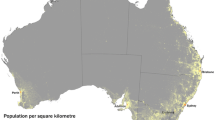Abstract
Aim
Winning young health professionals for rural areas is a very important challenge against the background of many retiring physicians in the coming decade and a growing unattractiveness of rural areas for future medical professionals. Through teleconsultation, a bridge can be provided between the single physician in the single practice in terms of professional exchange and second opinions. Teleconsultations between GPs and specialists are already in use in other countries (Lamminen et al. J Telemed Telecare 17(8):412–416, 2011; Nordal et al. J Telemed Telecare 7:257–265, 2001) but are not wide spread in Germany. The aim of this investigation is to identify the barriers and success factors for a teleconsultation solution in rural areas of northern Germany.
Subject and methods
A qualitative interview study was conducted among 18 experts from the Schleswig-Holstein health care system using a semi-structured interview guide. Seven representatives of health care institutions, six GPs, and five young health professionals were interviewed and the interviews systematically analysed according to predefined categories.
Results
The results of this study show that the primary barriers preventing the adoption of teleconsultation are the high time-consumption, the physicians’ personality, and the financing possibilities of such solutions. The main factors of a successful adoption of teleconsultation include an easy usability of the system, good training opportunities, voluntary participation, the existence of a model region, and a reasonable financing plan.
Conclusion
A consideration of the results when setting up a teleconsultation solution provides a basis for a working teleconsultation system in rural areas that can help attract more physicians to those regions.
Similar content being viewed by others
References
Beneker C (2011) Kommt schon bald Telemedizin auf Rezept? http://www.aerztezeitung.de/praxis_wirtschaft/telemedizin/article/644564/kommt-schon-bald-telemedizin-rezept.html?sh=2&h=430246025. Accessed 26 June 2012
Feussner H, Etter M, Siewert JR (1998) Telekonsultation. Chirurg 69:1129–1133
Jacob R, Heinz A, Décieux JP (2010) Berufsmonitoring Medizinstudenten. Universität Trier, Fachbereich IV Soziologie/Empirische Sozialforschung, Trier, Germany
Koch K, Miksch A, Schürmann C, Joos S, Sawicki PT (2011) The German health care system in international comparison. Dtsch Ärztebl 108(15):255–261
Kopetsch T (2010) Dem deutschen Gesundheitswesen gehen die Ärzte aus!: Studie zur Alterstruktur und Arztzahlentwicklung Bundesärztekammer und Kassenärztliche Bundesvereinigung, Berlin
Körtke H, Feige T, Gräfe B, Secer S, Paluczkiewicz S (2011) Virtuelles Krankenhaus. In: Duesberg F (ed) e-Health 2012. Medical Future, Verlag Solingen, pp 155–159
Lamminen J, Forsvik H, Vopio V, Ruohonen K (2011) Teleconsultation: changes in technology and costs over a 12-year period. J Telemed Telecare 17(8):412–416
Larsen F, Gjerdrum E, Obstfelder A, Lundvoll L (2003) Implementing telemedicine services in northern Norway: barriers and facilitators. J Telemed Telecare 9:17–18
Lehoux P, Sicottea C, Denisa J-L, Bergb M, Lacroixc A (2002) The theory of use behind telemedicine: how compatible with physicians’ clinical routines? Soc Sci Med 54:889–904
Meuser M, Nagel U (2009) Experteninterview und der Wandel der Wissensproduktion. In: Bogner A, Littig B, Menz W (eds) Experteninterviews, 9th edn. GWV Fachverlage, Wiesbaden, Germany
Moffatt JJ, Eley DS (2011) Barriers to the up-take of telemedicine in Australia: a view from providers. Int Electron J Rural Remote Health Res Educ Pract Policy 11:1–6
Nordal EJ, Moseng D, Kvammen B, Løchen M-L (2001) A comparative study of teleconsultations versus face-to-face consultations. J Telemed Telecare 7:257–265
Pietzsch JB, Gemünden HG, Bolz A (2001) Rahmenbedingungen und Erfolgsfaktoren telemedizinischer Innovationen [general conditions and success factors of telemedical innovations]. Biomed Tech 46(4):96–100
Richards H, King G, Reid M, Selvaraj S, McNicol I, Bredner E, Godden D (2005) Remote working: survey of attitudes to eHealth of doctors and nurses in rural general practices in the United Kingdom. Fam Pract 22(1):2–7. doi:10.1093/fampra/cmh716
Savage S, Collins-Mayo S, Mayo B, Cray G (2006) Making sense of generation Y. Church House, London
Schmidt CE, Möller J, Schmidt K, Gerbershagen MU, Wappler F, Limmroth V, Padosch SA, Bauer M (2011) Generation Y: Rekrutierung, Entwicklung und Bindung Der Anästesist 60(6):517–524. doi:10.1007/s00101-011-1886-z
Stanberry B (2000) Telemedicine: barriers and opportunities in the 21st century. J Intern Med 247:615–628
Wootton R, Bahaadinbeigy K, Hailey D (2011) Estimating travel reduction associated with the use of telemedicine by patients and healthcare professionals: proposal for quantitative synthesis in a systematic review. BMC Heal Serv Res 11:185
Acknowledgments
The authors would like to thank all interview partners for their participation and for sharing their opinion on this topic.
Conflict of interest
The authors declare that they have no conflict of interest.
Author information
Authors and Affiliations
Corresponding author
Additional information
I hereby certify that this paper consists of original, unpublished work and is not under consideration for publication elsewhere.
Rights and permissions
About this article
Cite this article
Olenik, K., Lehr, B. Counteracting brain drain of health professionals from rural areas via teleconsultation: analysis of the barriers and success factors of teleconsultation. J Public Health 21, 357–364 (2013). https://doi.org/10.1007/s10389-013-0565-8
Received:
Accepted:
Published:
Issue Date:
DOI: https://doi.org/10.1007/s10389-013-0565-8




